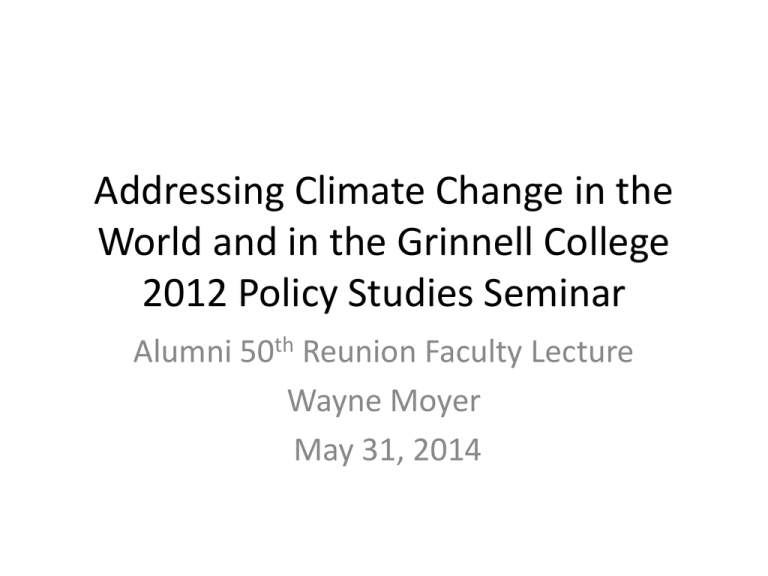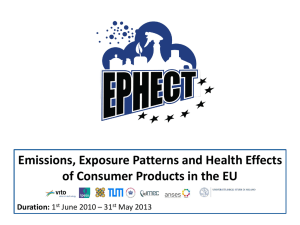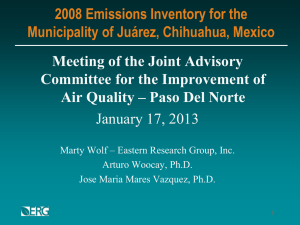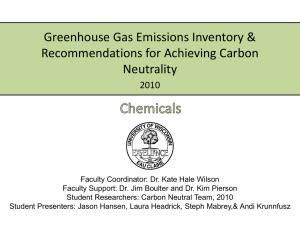50th Reunion Faculty Lecture
advertisement

Addressing Climate Change in the World and in the Grinnell College 2012 Policy Studies Seminar Alumni 50th Reunion Faculty Lecture Wayne Moyer May 31, 2014 New Information on Climate Change • Fifth Assessment Report of the Intergovernmental Panel on Climate Change (2013-2014) • National Climate Assessment (May, 2014) Anthropogenic Perturbation of the Global Carbon Cycle Perturbation of the global carbon cycle caused by anthropogenic activities, averaged globally for the decade 2002–2011 (PgC/yr) Source: Le Quéré et al. 2012; Global Carbon Project 2012 Fate of Anthropogenic CO2 Emissions (2002-2011 average) 8.3±0.4 PgC/yr 90% 4.3±0.1 PgC/yr 46% 1.0±0.5 PgC/yr 10% + 2.6±0.8 PgC/yr 28% Calculated as the residual of all other flux components 26% 2.5±0.5 PgC/yr Source: Le Quéré et al. 2012; Global Carbon Project 2012 CO2 in Atmosphere/Ocean and Ocean Acidification From the 2007 IPCC “Climate Change 2007, Physical Science Basis, Summary for Policy Makers http://www.ipcc.ch/pdf/assessment-report/ar4/wg1/ar4-wg1-spm.pdf Global Temperature and Carbon Dioxide 1880 1900 1920 1940 1960 1980 2000 From the 2007 IPCC “Climate Change 2007, Synthesis Report, Summary for Policy Makers http://www.ipcc.ch/pdf/assessment-report/ar4/syr/ar4_syr_spm.pdf Arctic Sea Ice From the 2007 IPCC “Climate Change 2007, Synthesis Report, Summary for Policy Makers http://www.ipcc.ch/pdf/assessment-report/ar4/syr/ar4_syr_spm.pdf From the 2007 IPCC “Climate Change 2007, Synthesis Report, Summary for Policy Makers http://www.ipcc.ch/pdf/assessment-report/ar4/syr/ar4_syr_spm.pdf Observed U.S. Precipitation Change Modeled Climate Change Predictions From the 2007 IPCC “Climate Change 2007, Synthesis Report, Summary for Policy Makers http://www.ipcc.ch/pdf/assessment-report/ar4/syr/ar4_syr_spm.pdf Fossil and Cement Emissions Global fossil and cement emissions: 9.5±0.5PgC in 2011, 54% over 1990 Projection for 2012: 9.7±0.5PgC, 58% over 1990 Uncertainty is ±5% for one standard deviation (IPCC “likely” range) Source: Peters et al. 2012a; Le Quéré et al. 2012; CDIAC Data; Global Carbon Project 2012 Total Global Emissions Total global emissions: 10.4±0.7PgC in 2011, 37% over 1990 Percentage land-use change: 36% in 1960, 18% in 1990, 9% in 2011 Land-use change black line: Includes management-climate interactions Source: Le Quéré et al. 2012; Global Carbon Project 2012 Emissions from coal, oil, gas, cement Emissions growth 2000-2011: coal (4.9%/yr), oil (1.1%/yr), gas (2.7%/yr), cement (6.9%/yr), flaring (4.3%/yr, not shown) Share of global emissions in 2011 Source: CDIAC Data; Le Quéré et al. 2012; Global Carbon Project 2012 Observed Emissions and Emission Scenarios Emissions are heading to a 4.0-6.1ºC “likely” increase in temperature Large and sustained mitigation is required to keep below 2ºC Linear interpolation is used between individual datapoints Source: Peters et al. 2012a; Global Carbon Project 2012; Challenges to keep below 2ºC An emission pathway with a “likely chance” to keep the temperature increase below 2ºC has significant challenges Short-term • Reverse emission trajectory • Emissions peak by 2020 Medium-term • Sustain emission trajectory • Around 3%/yr reductions globally Long-term • Net negative emissions • Unproven technologies Source: Peters et al. 2012a; Global Carbon Project 2012 Previous CO2 emission reductions Without climate policies, some countries have reduced emissions at 1-5%/yr Repeating with modern low-carbon technologies can “kick-start” mitigation Belgium Increased Nuclear Reduced Oil France Increased Nuclear Reduced Oil & Coal Sweden Increased Nuclear Reduced Oil United Kingdom Coal to gas Reduced Oil Increased Nuclear Grey areas are: World War I, Great Depression, World War II, oil shocks Source: Peters et al. 2012a; CDIAC Data; Global Carbon Project 2012 The recent shift from coal to gas in the USA The recent shift from coal to gas in the US could “kick start” mitigation To keep below 2ºC requires a shift to technologies with lower emissions Grey areas are: World War I, Great Depression, World War II, oil shocks Source: Peters et al. 2012a; CDIAC Data; Global Carbon Project 2012 Top Fossil Fuel Emitters (Absolute) Top four emitters in 2011 covered 62% of global emissions China (28%), United States (16%), EU27 (11%), India (7%) The growing gap between EU27 and USA is due to emission decreases in Germany (45% of the 1990-2011 cumulative difference), UK (19%), Romania (13%), Czech Republic (8%), and Poland (5%) Source: CDIAC Data; Le Quéré et al. 2012; Global Carbon Project 2012 Top Fossil Fuel Emitters (Per Capita) World average per capita emissions in 2011 were 1.4tC/p China (1.8tC/p), United States (4.7tC/p), EU27 (2.0tC/p), India (0.5tC/p) Chinese per capita emissions are almost equal to the EU27, and 36% higher than the global average Source: CDIAC Data; Le Quéré et al. 2012; Global Carbon Project 2012 Main Points to Take Away • The world is dumping 9.3 Billion metric tons Carbon Dioxide (CO2) into the atmosphere each year; over 40% comes from the U.S. and China • 4.3 Billion metric tonnes of CO2 stays in the atmosphere, with the remainder removed by the ocean or land sinks • There is scientific certainty of the atmospheric greenhouse effect – that as CO2 levels increase, more heat from the sun’s radiation is absorbed. • If the world continues producing greenhouse gases as it is doing now we can expect average temperature increases by 2100 to increase somewhere between 4 to 6 degrees Celsius. This would have catastrophic effects on water, ecosystems, food, coasts and health. • There is uncertainty about the climate effects in particular localities. But, it appears that the most dramatic effects will be felt in the poorest areas of the world, with the least ability to adapt. These are not the regions that are producing the largest quantities of greenhouse gases • Global CO2 emissions continue to increase rapidly, particularly in China and to a lesser extent in India. The principal source of new emissions in coal used in power plants. Coal is responsible for 40 percent of global CO2 emissions. • There is international consensus that we should prevent global temperatures from rising more than 2 degrees Celsius by 2100. To do so, emissions would probably have to peak by 2020 and decline by 3.5 percent annually • We are not close to achieving this goal. Emissions in the United States and Europe are already declining, but at less than half the rate required for the world to keep the global temperature increase within 2 degrees Celsius. • The underlying international policy issue is the division of responsibility for emissions cuts. The developing nations argue that most of the burden should be on the industrial nations who have produced most of the emissions. The industrial nations argue that all nations must take significant action if climate is to be stabilized Approaches to International Action to Limit Climate Change • All international agreements depend on state consent (sovereignty). No enforcement mechanisms – Top-down approaches – define particular policies and measures that parties must undertake – Bottom-up approaches – allow parties to define their own contributions Framework Convention on Climate Change • • • • • Signed 1992; Entered into force 1994 191 countries and European Union are parties Stabilization of Greenhouse Gases in Atmosphere Common but differentiated responsibilities Parties develop and report on current and projected measures to combat climate change (bottom-up) • Parties undertake to limit emissions • Industrial countries aim to return emissions to 1990 levels by 2000 (top-down) Kyoto Protocol • Signed 1997; entered into force 2005 • 190 countries and European Union are parties • Emissions Reduction targets for industrial countries 2008-2012 average 5%; U.S. 7% (top-down) • Flexibility Mechanisms – Emissions trading – Joint Implementation – Clean Development Mechanism • Measures to increase carbon uptake from forests and other sinks • Adaptation Fund December 2009 Copenhagen Climate Conference • Shift from emission targets to pledge and review (bottom-up) • Aspirational goal to limit global warming to +2 degrees Celsius • Developed countries implement economy-wide emission targets by 2020; developing countries implement mitigating action; least developed countries take voluntary action • Reporting, measurement and verification of country actions • Developed countries commit $30 Billion in “new and additional” funding 2010-2012 to help developing countries reduce emissions, preserve forests and adapt to climate change • Ad Hoc Working Group to work toward fuller agreement in Mexico Dec. 2010 • Goal of mobilizing $100 Billion a year by 2020 to address developing country needs • Mechanism to support efforts to reduce emissions from deforestation and forest degradation • Establishment of Copenhagen Green Climate Fund Recent FCCC Conferences 2010 - Cancun – integrated essential elements of the Copenhagen framework into the Framework Convention on climate change; national pledges 2011 – Durban – established Green Climate Fund; steps toward a second Kyoto commitment; decision to seek new covenant by 2015 to go into force in 2020 2012 – Doha – Authorized extension of Kyoto for eight years; made commitment to provide future resources for Green Climate Fund; developed workstream for 2015 agreement; steps toward measurement, reporting and review 2113 – Warsaw – Nationally determined contributions presented in first quarter of 2015 - but nothing on rules, scope and legal nature of contributions Issues for a New Climate Agreement – Paris 2015 • • • • • • • • Legal form Long-term goal Nature of commitments Transparency/Accountability Equity/Differentiation Adaptation Support for developing countries Land use Obstacles to Progress in FCCC Negotiations International GHG assessment • High transactions costs to reach agreement – different interests – poor incentives to keep agreement -weak international institutions to enforce agreements – strong incentives to free-ride • Problem in measuring emissions and in ensuring compliance • Divide between Industrial and Developing nations • Unwillingness of the U.S. to accept emission caps and timetables without emissions reduction commitments from developing countries • Unwillingness of developing countries to accept emissions reductions commitments arguing that development should come first Policies to Deal with Climate Change Market Policies Carbon Tax Cap and Trade Command and Control (performance targets) Fuel Efficiency standards Renewable energy standards Emissions standards Impediments to Policy Development in United States • The negative effects of climate change are not obvious to the majority of people. • Climate change policies have immediate costs and only long-term benefits. • Climate change policies probably will lead to increased cost for electricity and gasoline. These costs are directly linked to economic growth and jobs. • Fossil fuel interests are well-organized and strong. • Climate change policy has become highly partisan. United States Policy • National policies exclusively command and control – not efficient, but benefits are clear and costs to individuals are hidden • Cap and Trade attempted in 2010, but failed in Senate. Some of the reasons for failure included: 1) fear that energy prices would rise; 2) the recession; 3) issue became partisan; 4) lobbying by fossil fuel interests President Obama’s June 25,2013 Climate Initiative • Directive to Environmental Protection Agency to limit amount of Carbon Dioxide that power plants can produce • Strengthen fuel efficiency standards for buses and trucks • $8 Billion in loan guarantees for deployment of technologies that make fossil fuels less harmful • Encourage wind farms and solar arrays on federal lands • Strengthen energy efficiency in federal buildings State Policies General Policies Regulation: electricity, natural gas, infrastructure and land use Greenhouse Gas Targets: 20 states Renewable Energy Standards: 29 states Regional Initiatives California: Cap and Trade: Emissions to 1990 levels by 2020 Proposition 39: $2.5 Billion to Energy Conservation Solar Power Subsidy Strict Renewable Energy Standards Toward More Effective Action in the Future United States: Raise cost of carbon emissions: carbon tax or Cap and Trade Tougher command and control measures Government investment in new technologies and infrastructure Need to mobilize public engagement Internationally: Negotiations in smaller forums than FCCC Commitments contingent on action by others Strengthen incentives for cooperation Work to get firm commitments to cuts by the U.S. and China Getting Emissions Commitments from the U.S. and China Why firm commitments are difficult even though leaders in both countries understand the need for action U.S. – fears loss of competitiveness if commitment not reciprocated by China; strength of fossil fuel lobbies; fear of consumer retribution if electricity prices rise China – legitimacy of communist party depends on growth; dependency on coal; distorted energy prices; politically powerful industries; Can an agreement be reached? The outlook will be more positive if agreements can be reached to transfer U.S. technologies while protecting intellectual property rights. China-U.S. July 10, 2013 Agreement • Five Part Plan to cut carbon emissions, pledging to make heavy-duty vehicles more efficient and to do more to limit the output from coal-fired plants. • Pledged to promote energy efficiency in buildings, improve greenhouse data collection and management and smart grids. PST/POL 320- Applied Policy Analysis Climate Change • Course Objectives – Understanding of climate change policy domestically and internationally – How government regulations and market incentives compare as a vehicles for mitigating climate change – What are the limits of domestic and international institutions in addressing climate change? – How can we bring science and conceptions of justice to bear in influencing the policy process? – What are the pros and cons of various strategies to address climate change? – Are top-down or bottom-up strategies more effective? – How does the intergenerational character of climate change affect policy development? PST/POL 320 – Applied Policy Analysis Climate Change • Introduction- Books – Mike Hulme, Why We Disagree About Climate Change – David G. Victor, Global Warming Gridlock • The Climate Change Challenge – – – – The Discovery of Climate Change Climate Change Science Overview IPCC Climate Change 2007 Synthesis Report National Research Council, “Climate Change: Evidence, Impact and Choices Policy Models and Climate Change • Rational Decision Making Model: complete information about problems and solutions allows all options to be weighted and the best one chosen. • Bounded Rationality Model: behave as rational as possible given limited time and information • Incremental Model: policy in small steps so that decision makers can process results—an application of bounded rationale model • Organizational Behavior (Bureaucratic) Model: huge organizations as part of standard operating procedure have ways of making decisions which lead to incremental change, grounded in bounded rationality • Governmental Politics: policy results from persuasion, competition, bargaining (similarly to policy/politics stream of Kingdon). • Three Streams: Policy, Politics, Problem streams all need to intersect to open a policy window Obstacles to Action on Climate Change • Uncertainty, risk, deniers • Paper to persuade skeptic that climate change is real • Science, economics, politics, the power industry • Presentations: Country impacts of climate change • Why people disagree – values, beliefs and fears Paper to Convince a Skeptic • Write a paper aimed at assigned skeptic presenting the scientific arguments for why that person/group should be concerned about climate change. • Skeptics included: – – – – – Midwest farmer Coal Mine executive United Auto Workers Walmart Executive Homemaker - Chamber of Commerce - Highway construction executive - Banker - Power company executive - Rural County Board Student Country Projects Asia – Korea, Japan, China, India and Indonesia Latin America – Mexico and Brazil North America – United States and Canada Europe – European Union and Russia Australia Small Island States National and International Action on Climate Change • Action so far in the international context – Framework Convention on Climate Change – Kyoto Protocol – Copenhagen and Post-Copenhagen agreements • Action in the United States – Executive regulations – Congress – State and local action • Paper to convince a skeptical legislator to readdress climate change Paper to Convince a Skeptical Legislator • Write a short (3-5 pages) paper to persuade a skeptical legislator of the merits of readdressing climate change • Some of the legislators were: – Senator Chuck Grassley - Iowa – Senator Pat Roberts - Kansas – Senator John McCain - Arizona – Senator John Cornyn -Texas – Senator Lindsay Graham – South Carolina Alternative Directions for the Future • • • • The challenges of development and governance Two-level bargaining games Political institutions and international regimes Dimensions of climate strategy – engaging the enthusiastic and reluctant countries • Promoting Technological Change • Student paper on country actions to deal with climate change • Thinking Ahead Finishing the Course • • • • Technology poster presentations Doha Conference simulation Country poster presentations Final Papers Technological Solutions to Climate Change - Posters • • • • • • • • Wind Solar Nuclear Conservation Carbon Storage Geo-engineering Fracking Coal Carbon Capture and Storing Nuclear Energy Wind Power Solar Power Areas of Solar Power Potential Fracking Coal Carbon Capture and Storage Geoengineering








